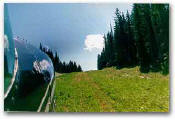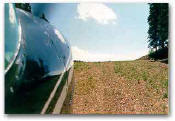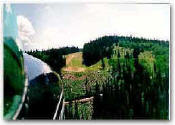You're Landing Where?
 I've
seen emergency
I've
seen emergency
runaway-truck ramps
that looked friendlier
than this strip.
By Gaile Imeson
When my spouse of three weeks invited me along on a mountain-flying excursion, I was excited and eager to see it all on an up-close-and-personal level.
A seasoned-world traveler who has spent many years in the mountains of Wyoming and Colorado, I couldn't wait to fly into this new adventure.
The first leg of our journey was a beautiful flight from Denver to Glenwood Springs, Colo. The mountains are high and rugged. Many times I've flown over them on commercial flights and have skied and hiked in them. They are much bigger when viewed from the cockpit of the little Cessna 170B. They are really big.
We looked forward to meeting Murray Detwiler, a competent mountain pilot, who had flown a Cessna 172 into Possum Creek several times. My husband wanted to discuss mountain-flying techniques with Murray. We were saddened to learn that Murray has passed away just the day before, on July 12, 1994. He had become ill the night before and the tragic loss came quickly.
Our host for our adventure, Dave Force Jr. is a quiet, unassuming, good-natured man. I sat patiently as Force explained the technique for landing at Possum Creek, in words a toad-stool could have understood.
Since I'm an absolute novice at this stuff, I kept glancing at my husband, Sparky, and he seemed satisfied with Force's explanation.
Force has been flying to Possum Creek for nine summers and has made more than 400 landings there, with only a couple of arrivals
Although Force jokingly refers to this strip
as "Possum Creek International Airport,"
I was soon to discover it bears no resemblance
to an airport of any kind.
Force explained that an east wind is critical, with the potential of creating a fatal, or at least an unrecoverable downdraft. We would fly by the strip, north to south near the lower-west end to test for sinking air. I licked my finger and unobtrusively stuck it in the air. Yes, I still haven't a clue.
I hear him explain there is no such thing as a descending approach to this strip. That makes it necessary to carry extra airspeed to transition from a descending flight path to a flight path paralleling the 20-percent upgrade of the strip. Only then could a normal landing be attempted. Any excess airspeed with this descending technique, and one gambles with running out of runway and going over the cliff at the east end, which drops off into Dry Possum Creek.
 My
ears perked up ... Gamble? Gulp. I remember
My
ears perked up ... Gamble? Gulp. I remember
being told the landing distance increases as the
square of the ratio of the touchdown speed
to the normal touchdown speed.
Now it seems important. We wouldn't
want to increase the landing distance
at Possum Creek!
My brain was ticking off words like "airspeed," "density altitude" and "runway elevation 10,010-feet in the sky." Why did he have to tell us these things? What was I doing here?
The time has come to board Force's Cessna 180, buckle up and take to the sky. Just a short, beautiful flight and we see it – Possum Creek International. Elevation at the top is 10,010 feet at the east end; at the west end, 9,840 feet. The runway is 1,360-feet long, cliff-to-cliff; with a vertical rise from bottom to top of 170 feet with a turn to the right.
All three of us have an adrenaline rush. Remember, this airstrip isn't out in the middle of a prairie. It's tucked in a ravine with its upper end sporting a 700-foot cliff dropping straight down to the treetops at the base of a very steep mountain. The lower end doesn't look much more hospitable.
"You guys are nuts! I'm getting out!" Well, maybe not. I came along for the thrill, so I may as well relax and be thrilled. Trees whiz by on both sides. No elk or deer jump out to greet us. Boy, it sure doesn't take long to land here! Besides one wheel hitting a bit sooner than the other, I was quite impressed with the smooth landing. It didn't hurt a bit. I breathe.
 As
we walked the strip, to really feel how steep it
As
we walked the strip, to really feel how steep it
is, I asked Force how he happened to choose this
spot. He explained that it had been a natural clearing.
Very little of the natural setting had been disturbed.
Wildflowers abound.
At the recommendation of the county extension office, he had seeded the strip with Tegmar grass to keep erosion at a minimum.
Elk and deer don't seem to mind the airplane intrusions. They are nearly always within a few yards of the strip. Bears love to tear up the seat on Force's 4x4, all-terrain vehicle, he sometimes leaves to ferry him to the ranch.
The dreaded sub-species of Homo sapiens, called "Rocky Mountain vandals," has been known to climb way up there and shove the ATV off the cliff.
A reminder here to those pilots who want the challenge of sneaking into this privately owned ranch strip ... don't. If you really want to land there, Force's share of Possum Creek ranch, along with barn structure, is for sale. You can use the airstrip if you buy a portion of the ranch. That's how it is, out here in the West. (Force has purchased a new ranch and is developing another strip. Phone him at 303-945-6858 for info.)
I hated to leave this fantastic setting. A few clouds were starting to bring some summer rain showers so we had to leave before this party got rough.
Force started the engine and did a limited run-up. Power was added. We started to roll, then whoosh ... that was it. We were airborne. Force sure didn't need the lower portion of the strip!
Another adrenaline rush — times three. My stomach sticks in my throat. We cruised around for a few minutes looking for elk and drinking in the scenery. Even a veteran-mountain pilot would have to be in awe of what we had just done. I see now why pilots get such a charge out of remote mountain landings.
Near Glenwood Springs, we got a good look at Storm King mountain and the charred remains from the forest fire that had taken the lives of 14 firefighters just days earlier.
Since I have never been to the highest 'public' airport in North America, we stopped off at Leadville. At 9,927 feet, it's not as high as Possum Creek, but it is an official airport and it is open to the public.
I have a whole-new healthy respect for those mountains and the pilots who fly them. When do we go again?
|
|
|


